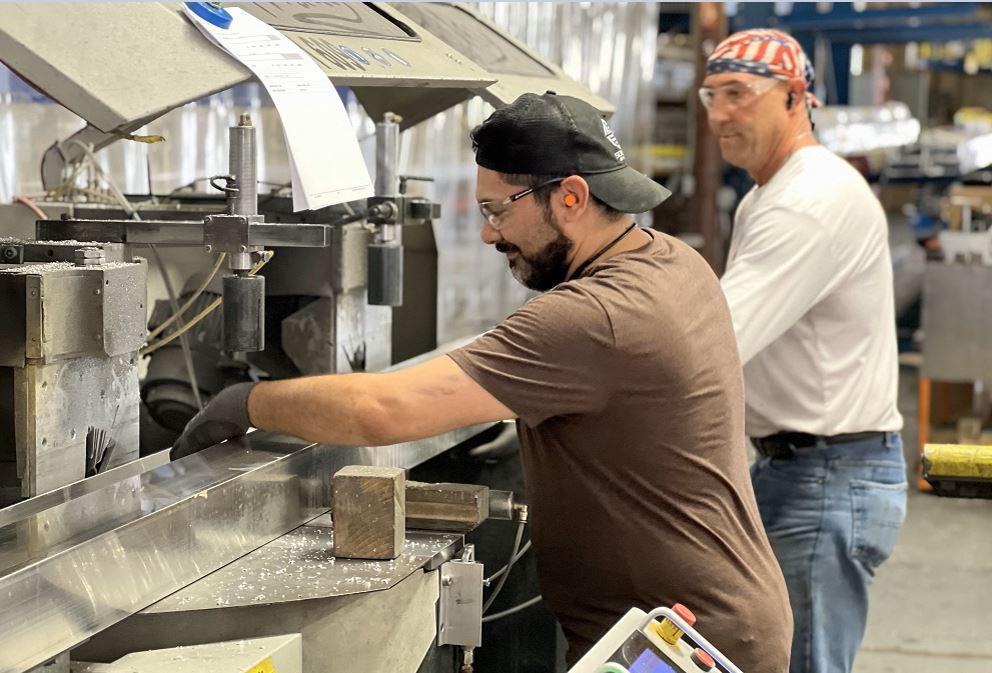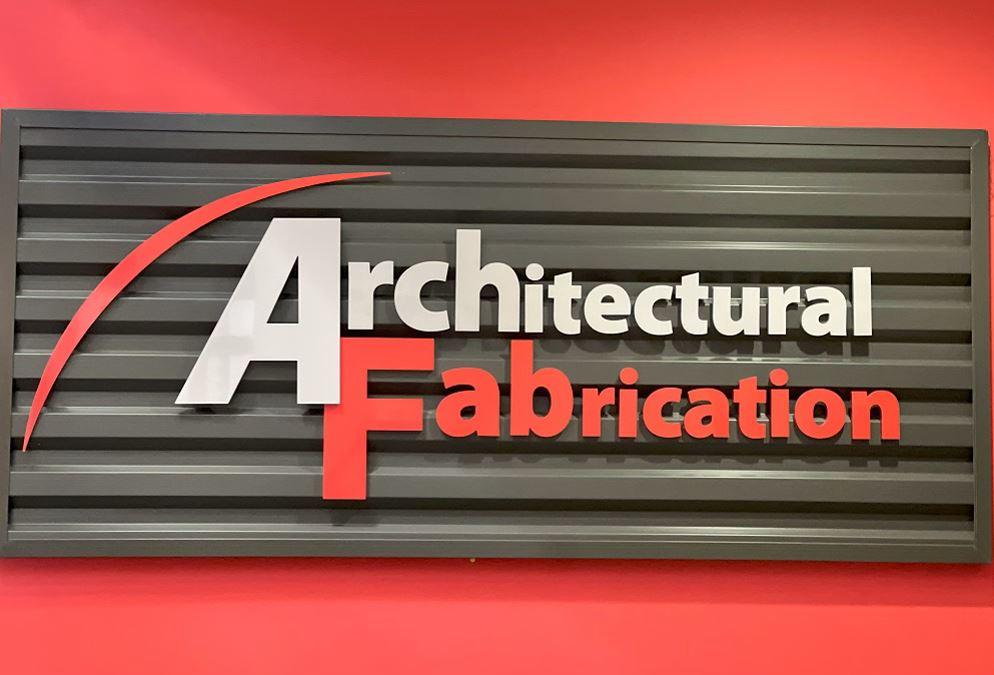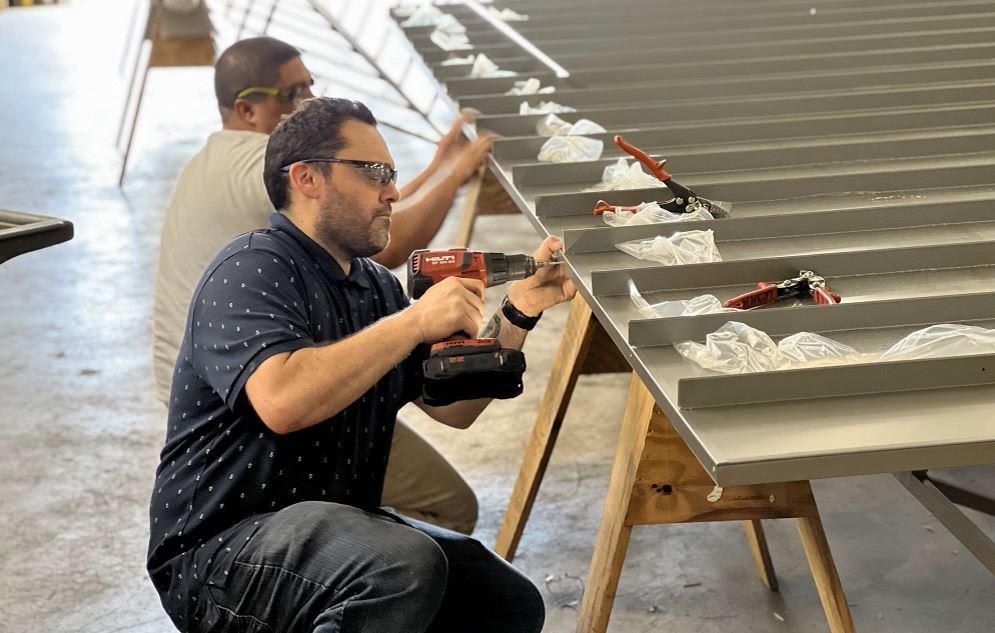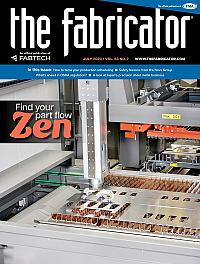Editor-in-Chief
- FMA
- The Fabricator
- FABTECH
- Canadian Metalworking
Categories
- Additive Manufacturing
- Aluminum Welding
- Arc Welding
- Assembly and Joining
- Automation and Robotics
- Bending and Forming
- Consumables
- Cutting and Weld Prep
- Electric Vehicles
- En Español
- Finishing
- Hydroforming
- Laser Cutting
- Laser Welding
- Machining
- Manufacturing Software
- Materials Handling
- Metals/Materials
- Oxyfuel Cutting
- Plasma Cutting
- Power Tools
- Punching and Other Holemaking
- Roll Forming
- Safety
- Sawing
- Shearing
- Shop Management
- Testing and Measuring
- Tube and Pipe Fabrication
- Tube and Pipe Production
- Waterjet Cutting
Industry Directory
Webcasts
Podcasts
FAB 40
Advertise
Subscribe
Account Login
Search
Scaling a manufacturing business with digital connectivity
Texas metal fabricator finds capacity after ditching its siloed systems for Salesforce
- By Dan Davis
- July 13, 2023
- Article
- Bending and Forming

At one time, the shop floor was just one more silo within the Architectural Fabrication company. After implementation of a cloud-based enterprise resource planning system, a customer relationship management package, and a project management tool, the fabricator of commercial shade products is now operating much more efficiently, while preparing a foundation for future growth.
When Jeff Cash joined Architectural Fabrication Inc., Fort Worth, Texas, as vice president of sales in the summer of 2015, it was a new start for him both literally and figuratively.
He had worked previously for a construction company, where he found his efforts to digitize workflow within the organization stymied. Company management had approved Cash’s plan to move away from paper-based project management and make the transition to a more digital workflow, where the goal was to create “repeatable processes that ultimately achieve repeatable success,” he said. But like in many companies, this digital initiative never really took off.
Trained in process and procedure as part of his Army ROTC training at Texas A&M in the mid-2000s, Cash wanted to find a place where he could pursue his passion—adopting systems that create efficiencies and allow people to shine. That’s why the start at Architectural Fabrication was so meaningful for Cash. He would have the support and resources to formalize sales—and ultimately other parts of the organization.
His influence has proven to have a very big impact on the company, which fabricates commercial shading products for customers all over the U.S. With $30 million in annual revenue and slightly more than 170 employees, Architectural Fabrication has its sights on being a $100 million company by 2031. To get where it is today and where it wants to go, Architectural Fabrication had to get organized. Cash helped them to do that.
In the Beginning: Signs and Awnings
Architectural Fabrication started out as a sign and awning fabrication shop in 1991, but its early history was similar to any new small business. If someone was willing to pay them to fabricate something, they would do it.
That remained the case for almost the next 20 years. The company had formally carved a niche in the Metroplex area, fabricating shade-providing products for its customers, but it still was like many other small shops spread all over the nation serving this architectural and roofing segment.
That changed around 2010 when Architectural Fabrication had the opportunity to land a big account with a national retailer that was undergoing a major rebranding. With that new branding, the company’s retail outlets needed new Bahama-style shutters (where the hinges are found at the top of the shutter instead of on the sides). Architectural Fabrication won the contract, and the opportunity forced the company to change its approach to the marketplace. Instead of custom-building every order, management started thinking about making product lines that it could tweak for certain shading applications. Cash said the company also decided it could focus on being an “end-to-end” architectural and shading product supplier.
“We’re unique in that we handle the project from estimating through installation. We get involved with the general contractors, scope out the work for them, provide them with a proposal and estimate related to the products that we can manufacture, and do the installation,” he added. “There are a lot of companies that will manufacture the product, but they won’t do any installation.”
Architectural Fabrication grew in the ensuing years after winning that big contract with the national retailer. Other similar nationwide accounts propelled the business forward as well. But to take advantage of further growth, some changes were needed.
Jeff Kenny, who arrived at the company to help win that original large contract with the retailer, took over ownership of Architectural Fabrication in 2015. Cash joined later in the year.

Architectural Fabrication wants to reach $100 million in annual sales revenue by 2031. Establishing a digitally connected enterprise is a key step toward achieving that goal.
A Systems Approach
When Cash arrived, he found a successful operation, but one that could be a lot more successful. All the pistons in the engine weren’t firing as they should.
“From a process standpoint, everything was kind of siloed. Every department knew what they were supposed to do, but our business is highly collaborative. From start to finish, there are a lot of handoffs throughout the project life cycle—from estimating to pre-construction, from the sales team putting together the proposal and then working with the operations team once the job is won,” he said. “A designer has to design it. A project manager has to manage it. They all have to collaborate with all our other internal resources to get it manufactured and installed.”
Sales was his first priority when he joined Architectural Fabrication, but Cash said he didn’t have much with which to work. The company had a free version of a customer relationship management (CRM) tool, and in this case, it was worth what the company paid for it. It offered basic contact organization, but it had no reporting capability. In terms of tracking deals, it could offer insight into a couple, but it couldn’t offer an overview of everything.
At the time, 50 or 60 projects could be active, and several other sales could be in the works. Without a firm feel for what was coming, that made forecasting and planning difficult.
In 2016, Architectural Fabrication started using the popular Salesforce CRM tool to organize its sales effort. At the same time, it also adopted a project management module that was part of the Salesforce ecosystem.
“We implemented those two tools at the same time,” Cash said. “The project management module was actually just available for us from the Salesforce AppExchange.
“The great thing about this is the ability to administer it on the back end—to do customizations and improvements,” he continued. “This ecosystem creates a really powerful tool for those uneducated in terms of software and coding. Everything is point and click. It’s click, not code.”
With Salesforce, Cash was painlessly able to start delivering monthly sales reports that were not filled with doubt. Projections were built on more accurate information as well, and as a result, large-scale surprises were minimized.
Architectural Fabrication experienced similar positive results with the project management module. Considering a static spreadsheet with more than 20 columns was once used to track jobs, Cash said any improvement in project tracking was going to be a big one.
The module allowed all of the functional areas of the Architectural Fabrication business to not only see the big picture, but also where they fit into the overall product delivery cycle. The project manager could assign deadlines and ultimately build out Gantt charts for the entire job, with each functional area being able to review and approve their scheduled contributions.

The final touches are put on a commercial shade product before it is shipped out for installation. Architectural Fabrication is one of a few companies in the U.S. that handles design, engineering, fabrication, and installation of these aluminum canopy systems.
“Everybody could see what was happening in a snapshot,” Cash said. “This is the timeline that fab’s operating on, so now construction can start planning. Installers can see when they need to be on-site for the installation work.”
The success experienced in the sales and project management areas would play an important role in rolling out the next big systems improvement—the rollout of an enterprise resource planning (ERP) system. Cash said he was confident that the sales and project management cloud-based software tools could boost morale and the performance of those using them, and that the good word would spread through other parts of the company, in particular the shop floor.
In order for an ERP implementation to be successful, it needs the shop floor to be engaged in collecting operational information and feeding that back into the system. Cash said that can be a challenge for someone who’s first priority is fabricating parts, not interacting with a computer all day.
“So we waited to implement ERP until we felt like we had the success cases in place and could sell it to the rest of our organization,” Cash added.
Meanwhile, by the end of 2016, Architectural Fabrication had moved into a new 86,000-sq.-ft. building with a 30-ft.-high ceiling. With more room, the company added more equipment, including a new CNC double-compound miter saw, which produced more efficient and precise cuts than the older saw it replaced. Because of the more accurate cuts, Cash said welders didn’t have to spend extra time filling large gaps, which were the result of the old saw’s cutting performance.
The Next Phase: ERP Implementation
In 2020, Architectural Fabrication made a decision to go with an ERP package that was built off the Salesforce Cloud Platform. Rootstock shares the same cloud and data model as the Salesforce CRM and project management module, making the ERP integration pretty seamless, Cash said.
“When we brought on the manufacturing ERP, one of the things that we were really looking to solve was to have a better tool for managing capacity,” he added. “Rootstock has a great capacity planning workbench tool that allows the project managers to create work orders and apply due dates for when the product needs to be fabricated. Our production team can see that on their side, and they’re able to go in and plan out their schedules based on their amount of capacity hours. Everything ends up being scheduled properly.”
The impact of the ERP package and overall digital connectivity of the organization made possible by the cloud-based programs has been huge, according to Cash. It’s allowed the company to manage more projects in general and do it more efficiently. In turn, that’s made work much more enjoyable for the project managers.
Looking back before the ERP implementation, Architectural Fabrication project managers used to oversee about 40 projects, valued at around $4 million. Cash said project managers were being pushed to the limit trying to stay on top of so much activity without the benefit of digital tools that provided real-time communication with colleagues and visibility into project schedules. “We could see it visibly in their work,” he said.
Now with the digital tools in place, a project manager at Architectural Fabrication can manage projects worth $10 million, about 100 total. Cash added, even with the expanded responsibilities, project managers aren’t as frazzled as they used to be.
“It’s a testament to how, if you can create the right systems and add automation, people can do so much more for your business,” Cash said.
The new digital connectivity across the company and the elimination of the silos that used to exist within the walls of Architectural Fabrication have influenced hiring as well. Whereas the company had spent years looking to hire people with fabricating experience or the right degrees, now they look for go-getters who want to learn about the business and understand the importance of customer service. New hires need to fit the company culture.
“Everything I’ve done within this business has been in a spirit of trying to create that place where people can thrive,” said Cash, who was named the company’s president in 2021. “It started with a focus on our employees, but we also want that to spread to the people that we work with—our vendors, suppliers, and our customers. We want everybody to thrive as a result of working with us.”
To Be Continued
Cash said Architectural Fabrication still has work to do, even with the early successes associated with the ERP implementation. Like anyone involved in lean manufacturing efforts will tell you, continuous improvement is a journey, not a project with an end date.
For example, Architectural Fabrication’s ERP system gives them clear visibility into projects, allowing them to compare actual hours to budgeted hours. Cash hopes to make process improvements, having his team collect detailed data on actual project costs, which could then be compared to the project’s overall budget to pinpoint excesses and improve profitability.
Having shop floor employees and erectors providing accurate input on a consistent basis opens the door to this type of detailed project analysis, but Architectural Fabrication still needs to find the right approach to ensure this reporting. Barcodes on products and barcode scanning might be one way to do this, Cash said.
He added that he hopes the company gets better at training people using a learning management system that is part of the Salesforce ecosystem. System users can click on any number of training modules that give them an overview and instruction on using tools found on the Salesforce Cloud Platform. It’s one of the benefits of working with digital tools designed for one platform and not a hodgepodge of software products that sit on a server and require special code to work with each other.
“We’re trying to provide a guided path for our employees,” Cash said. “If we can help tell them what the next steps are for like 80% of their work through these systems, they can spend so much more of their time focused on creative problem-solving and putting their own kind of spin on their work. They can exercise their individuality in their roles, being the project manager or pre-construction salesperson they want to be.
“That’s how we view our systems. It’s just a foundation to allow people to reach peak performance.”
About the Author

Dan Davis
2135 Point Blvd.
Elgin, IL 60123
815-227-8281
Dan Davis is editor-in-chief of The Fabricator, the industry's most widely circulated metal fabricating magazine, and its sister publications, The Tube & Pipe Journal and The Welder. He has been with the publications since April 2002.
subscribe now

The Fabricator is North America's leading magazine for the metal forming and fabricating industry. The magazine delivers the news, technical articles, and case histories that enable fabricators to do their jobs more efficiently. The Fabricator has served the industry since 1970.
start your free subscription- Stay connected from anywhere

Easily access valuable industry resources now with full access to the digital edition of The Fabricator.

Easily access valuable industry resources now with full access to the digital edition of The Welder.

Easily access valuable industry resources now with full access to the digital edition of The Tube and Pipe Journal.
- Podcasting
- Podcast:
- The Fabricator Podcast
- Published:
- 04/16/2024
- Running Time:
- 63:29
In this episode of The Fabricator Podcast, Caleb Chamberlain, co-founder and CEO of OSH Cut, discusses his company’s...
- Trending Articles
Tips for creating sheet metal tubes with perforations

JM Steel triples capacity for solar energy projects at Pennsylvania facility

Are two heads better than one in fiber laser cutting?

Supporting the metal fabricating industry through FMA

Omco Solar opens second Alabama manufacturing facility

- Industry Events
16th Annual Safety Conference
- April 30 - May 1, 2024
- Elgin,
Pipe and Tube Conference
- May 21 - 22, 2024
- Omaha, NE
World-Class Roll Forming Workshop
- June 5 - 6, 2024
- Louisville, KY
Advanced Laser Application Workshop
- June 25 - 27, 2024
- Novi, MI


























